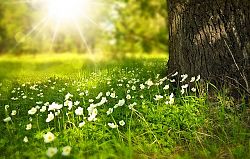

A study has found that as the climate heats up, plants are flowering a month earlier in the UK.
Researchers in the study examined 420,000 recorded dates of first flowering for more than 400 species, dating back to 1793. Up until 1986, the average date for the first blooms was around 12 May, but since then, the date has been pushed forward to 16 April.
Herbaceous plants saw the biggest advance, producing flowers an average of 32 days earlier. Trees blossomed 14 days sooner and shrubs advanced by 10 days. The researchers think that the faster-reproducing herbaceous plants are able to more easily adapt to the warming climate.
During the last recorded year (2019), spring arrived as far as 42 days earlier than the pre-1986 average. The difference between flowering times in the North of the UK (above Stoke-on-Trent) and the South has shrunk from nine days before 1986 to four days afterwards. This is most likely due to the period of accelerated global heating after the mid-80s, caused by fossil fuel burning and other human activities.
Leading the research at the University of Cambridge, Professor Ulf Büntgen, said: "The results are truly alarming, because of the ecological risks associated with earlier flowering times. When plants flower too early, a late frost can kill them – a phenomenon that most gardeners will have experienced at some point".
He added that the even bigger risk is "ecological mismatch". This is when plants and hibernating or migrating insects, birds and other wildlife are no longer synchronised. This can "lead species to collapse if they can’t adapt quickly enough". These mismatches are already being seen, for example, between orchids and bees, and great tit chicks and their crucial caterpillar food.
The researchers concluded that if plants in the UK continue to flower earlier, and the climactic extremes increased further, then "biological, ecological and agricultural systems will be at an unprecedented risk". For example, farmers could suffer if fruit trees flower early and then a subsequent late frost killed the entire crop. While it could be difficult for people to see the significance of average global warming of 1C, Büntgen has said plants flowering a month earlier has demonstrated the clear change.
The study was published in the Proceedings of the Royal Society B Journal, and it examined the first flowering dates from the Channel Islands to Shetland, and then from Northern Ireland to Suffolk. As the data available for individual plants were very variable both over time and in geographic coverage, the study did not highlight specific species. The study did note that there were now hundreds of records of both snowdrops and hellebores flowering before New Year's Day, as well as dozens of such records for primroses, winter aconites and lesser celandines.
Scientists found that the earlier flowering dates correlated strongly with the average daily maximum temperature from January to April, which rose from 7.8C (in 1952 - 1986) to 8.9C (within 1987 - 2019). The researchers did not find a link with the day's length, but they said this cue used by plants may become important if the average flowering dates are brought forward into February in the future. Their data showed that flowering had advanced by 15 days more than the UK Spring Index used by the government, including two species, Hawthorn and Horse Chestnut.
John David of the Royal Horticultural Society commented: "The main focus of this study is on native plants and so we don’t yet have a clear picture of the full impact of these changes on garden plants, but we would expect a similar pattern and have seen indications of this in our own gardens, such as the apple flowering times in our orchard at Wisley. The UK’s 30 million gardeners have an important role to play therefore in supporting our native biodiversity and counteracting the effects of any mismatch between flowering times and dependent wildlife. Our Plants for Bugs research, for example, shows what plants you can grow that will support biodiversity all year round".
The flowering date records used in the study are from Nature's Calendar, a collection of 3.5 million observations of seasonal change, maintained by the Woodland Trust and the Centre for Ecology and Hydrology. Many of the records are actually provided by citizen scientists, and anyone in the UK can submit data.
Büntgen called for more people to participate: "It is the world’s largest dataset and it’s superb, but it’s not enough. Updating the dataset every year is extremely valuable, because this is the only tool we have to really understand how climate is affecting our ecosystems. This is not something we can model".